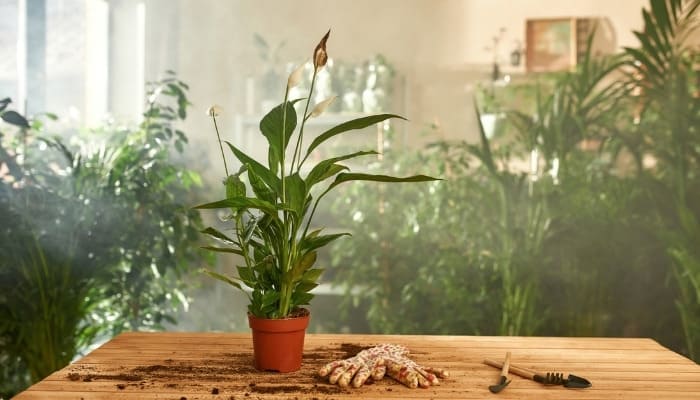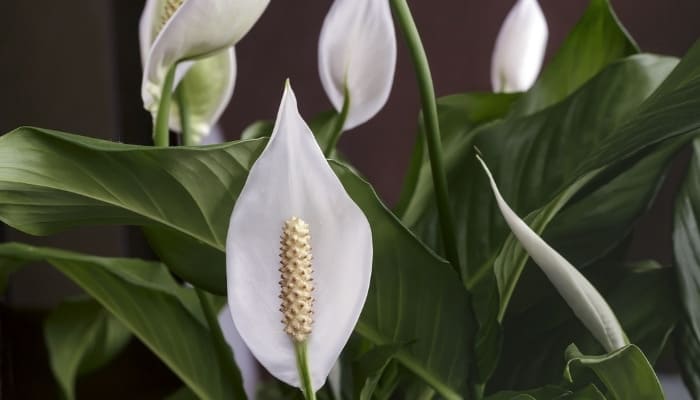Peace lilies are considered to be one of the top choices when it comes to indoor plants. This tropical species boasts vibrant green foliage and beautiful, decorative white flowers.
It doesn’t require much maintenance, and its growth rate is not so fast and aggressive that you’d need to clean up after it often.
However, more than other houseplants in your home, peace lily needs regular repotting.
Do peace lilies like to be root bound? The peace lily is one of those tropical plants that thrive when root bound. Before the plant shows signs of stress, its roots would have explored every inch of soil in the pot, but sooner or later, the root ball runs out of space and the soil becomes depleted. Then it’s time to repot it.
How often you need to repot your peace lily depends on the growing condition and the age of the plant. Keep reading to find out when and how to repot your peace lily.
When To Repot Peace Lily
Although the peace lily enjoys the tight spaces in the pot as the roots get entangled, the plant eventually needs repotting.
Sometimes you’ll need to repot it even when the roots are not bound and the container is still too big for the root system.
Root Bound Symptoms in Peace Lilies
The first sign that the peace lily is root bound is when the leaves start to droop.
They can droop and become curly about a week after watering, which is a sign that the roots cannot absorb any more moisture or nutrients due to a lack of soil.
This will be followed by wilting stems and the flowers withering and eventually dropping. In severe cases, the plant might die if you don’t repot it.
Other Times When Repotting Is Necessary
Being root bound is just one reason you should repot these tropical perennials. Other times you might need to repot the plant is if it has root rot.
This often happens when the plant sits in wet soil for too long. Root rot damages the root ball and leads to death.
Worn out, nutrient-depleted soil also calls for repotting of the plant.
How Often Should You Repot a Peace Lily?

Although peace lilies do not have an aggressive growth rate, their root system is a different matter. The root ball of the lily tends to grow and spread in its search for nutrients and moisture.
This means you’ll need to repot the peace lily once a year.
How To Repot a Peace Lily
The peace lily is prone to transplant shock if you don’t handle the repotting with care. Follow these steps to repot your peace lily and keep it healthy.
- Start by selecting a pot 2 inches larger than the old pot.
- Fill the pot one third full with a potting mix that contains peat moss, perlite, and loam soil in equal portions.
- Ease the peace lily out of the pot gently, and examine the root ball.
- Trim any damaged or rotten leaves.
- Spread the roots out, and make sure they’re not entangled.
- Place the plant in the new pot as quickly as possible, and spread the root ball so that it fills up the pot.
- Fill the sides of the pot with soil until 1 inch from the top edge.
- Firm the soil to push out air pockets, and ensure that the plant is standing upright on its own.
- Water the peace lily thoroughly to ease transplant shock and help the soil settle.
Peace Lily Care Indoors
Although your peace lily is not a fussy plant, it still needs some care to keep growing successfully in your house.
Peace Lily Soil
The peace lily prefers well-draining and rich soil. Neither sandy nor clay soil will do as the lily needs the soil to retain moisture long enough for the roots to absorb it but not become waterlogged.
For the right type of potting mix, add loamy soil from the garden to perlite and peat moss at a ratio of 1:1:1. Mix well, and use it to repot the peace lily.
Peace Lily Lighting & Temperature
As tropical plants, peace lilies thrive in temperatures between 70 to 75 degrees Fahrenheit. Don’t let the temperature drop below 60℉ since that can stunt the growth of the plant.
It also needs bright but indirect lighting. Place it near a window facing either the east or north, and avoid exposing it to the afternoon sun.
Watering Peace Lily
Watering lightly but regularly is the key to keeping the peace lily happy. Keep the soil moist but not wet.
If the soil dries out, the plant will show signs of stress where the leaves will drop then curl up. Long periods of drought will stunt the growth of the plant.
Peace Lily Fertilizer
Although not heavy feeders, the peace lily needs fertilizing at least once every 3 weeks during the spring and summer.
Use a general-purpose balanced fertilizer for houseplants (this one is excellent), and apply it at half strength. Hold off fertilizing at the end of the summer.
Dividing Peace Lily
Mature peace lilies start to develop clumps or several crowns. This calls for dividing the plant and starting new peace lilies in their own pots. Follow these steps.
- Always use sterilized equipment to avoid infecting the plant.
- Stick a twig in the soil and wiggle it to loosen the plant and make it easier to pull it out.
- When the plant is out of the pot, clean the root ball and get it untangled.
- Examine the roots, and identify the different crowns that have developed.
- Separate the crowns using a knife, or simply pull them apart without damaging the roots.
- Repot the mother plant, and plant each new crown in its own pot.
Related Questions:
Do Peace Lilies Like To Be Misted?
High humidity is crucial for the success of the peace lilies. Mist the plants regularly, or place the pot in a tray full of water and pebbles.
Do Peace Lilies Need Sun?
Peace lilies need bright but indirect light. Morning sun is recommended, and avoid exposing them to the afternoon sun. Direct sun could scorch the leaves and cause the plant to dry out.
Conclusion
Even if peace lilies enjoy being root bound, you still need to repot them once the leaves droop or become curly. Repot the tropical plant once a year to keep it healthy.

